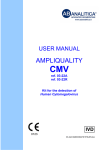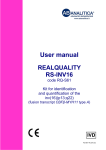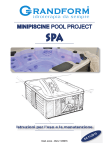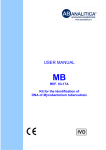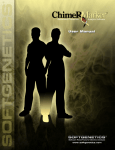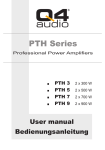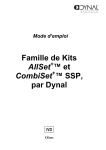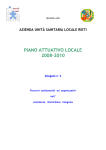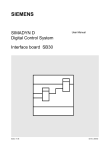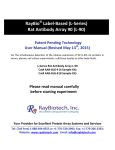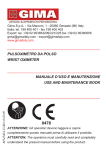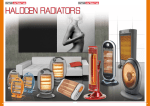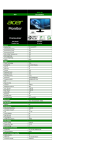Download STR-VNTR
Transcript
USER MANUAL STR-VNTR REF. 04-20A REF. 04-20R Kit for monitoring of the engraftment of allogenic bone marrow transplantation. 04-20A-50(8033622781257)-EN.doc 1. PRODUCT INFORMATION 4 2. KIT CONTENT 5 3. STORAGE AND STABILITY OF REAGENTS 8 4. PRECAUTIONS FOR USE 8 5. SAFETY RULES 9 5.1 General safety rules 9 5.2 Safety rules about the kit 10 6. MATERIALS REQUIRED, BUT NOT PROVIDED 12 6.1 Reagents 12 6.2 Instruments 12 6.3 Materials 12 7. REAGENTS PREPARATION 13 8. INTRODUCTION 14 9. TEST PRINCIPLE 15 10. 16 10.1. PRODUCT DESCRIPTION Information about the markers 17 11. COLLECTION, MANIPULATION AND PRE-TREATMENT OF THE SAMPLE 19 11.1 Fresh or frozen blood (peripheral and bone marrow) 19 12. 19 PROTOCOL pag.2 04-20A-50(8033622781257)-EN.doc 12.1. DNA extraction from peripheral or bone marrow blood (fresh or frozen) 19 12.2. DNA amplification 20 12.2.1. Amplification of the Hum ARA, Hum TH01, SE33, D1S80, 3’-HVR markers 20 12.2.2. Amplification of the vWF1, vWF2, YNZ22 markers 21 12.3. Visualization of the amplification products 12.3.1. Agarose gel electrophoresis 12.3.2. Sample loading on the gel 12.3.3. Interpretation of the results 12.3.4. Polyacrylamide gel electrophoresis 12.3.5. Sample loading on the polyacrylamide gel 12.3.6. Gel staining with Ethidium Bromide 23 23 23 24 26 27 27 13. TROUBLESHOOTING 29 14. DEVICE LIMITS 31 15. DEVICE PERFORMANCES 31 15.1. 16. Specificity 31 BIBLIOGRAPHIC REFERENCES pag.3 04-20A-50(8033622781257)-EN.doc 32 1. PRODUCT INFORMATION This user manual describes the instructions for use of the following products: STR-VNTR (cod 04-20A) Kit for monitoring of the engraftment of allogenic bone marrow transplantation by amplification of Short Tandem Repeat (STR) and Variable Number of tandem Repeat (VNTR) sequences. The kit includes the reagents for amplification and visualization by agarose gel electrophoresis, the internal control of sample amplificability and the positive control. Code 04-20A-25 04-20A-50 Product STR-VNTR STR-VNTR Pkg 25 test 50 test STR-VNTR (cod 04-20R) Kit for monitoring of the engraftment of allogenic bone marrow transplantation by amplification of Short Tandem Repeat (STR) and Variable Number of tandem Repeat (VNTR) sequences. The kit includes the reagents for amplification, the internal control of sample amplificability and the positive control. Code 04-23R-25 04-23R-50 Product STR-VNTR STR-VNTR Pkg 25 test 50 test pag.4 04-20A-50(8033622781257)-EN.doc 2. KIT CONTENT NOTE: In the kits with different codes (A or R) different components are included. (legenda: X = component included in the kit; 0 = component not included in the kit) BOX P cod. 04-20A cod. 04-20R STORE AT – 20°C X X Taq DNA polymerase termostable X X 10X Buffer X X dNTPs solution dNTPs 1x500 µl 1x900 µl X X MgCl2 solution MgCl2 1x150 µl 1x250 µl X X Single-dose premix tubes for HUM ARA Colourless (P) 25 50 X X Single-dose premix tubes for TH01 Blue (P) 25 50 X X Single-dose premix tubes for SE33 Yellow (P) 25 50 X X Single-dose premix tubes for D1S80 Red (P) 25 50 X X Single-dose premix tubes for VwF2 Green (P) 25 50 X X Primer vWF1 3’ Primer vWF1 3’ Yellow 1x60 µl 1x10 µl X X Primer vWF1 5’ Primer vWF1 5’ Yellow 1x60 µl 1x110 µl X X Primer YNZ22 3’ Primer YNZ22 3’ White 1x60 µl 1x110 µl X X Primer YNZ22 5’ Primer YNZ22 5’ White 1x60 µl 1x10 µl X X Primer 3’-HVR 3’ Primer 3’-HVR 3’ Violet 1x60 µl 1x110 µl X X Primer 3’-HVR 5’ Primer 3’-HVR 5’ Violet 1x60 µl 1x110 µl X X Glycerol 1X150 μL 1X300 μL DESCRIPTION LABEL TUBE (T) OR LID COLOUR 25 test 50 test AB TAQ 5 U/μL Red 1x150 µl 2x150 µl 10X Buffer 1x500 µl 1x900 µl Glycerol pag.5 04-20A-50(8033622781257)-EN.doc BOX F* cod. 04-23A cod. 04-23R STORE AT -20°C X 0 DESCRIPTION APS 10% LABEL TUBE (T) OR LID COLOUR 25 test 50 test APS Blue 8 X 600 μL 15 X 600 μL BOX F cod. 04-23A cod. 04-23R STORE AT +2°/ +8°C X 0 Electrophoresis loading buffer (6X solution) X 0 Ethidium Bromide solution (2,5 mg/mL) X 0 DNA Molecular Weight Marker (MW) DESCRIPTION LABEL TUBE (T) OR LID COLOUR 25 test 50 test Bromophenol blue Blue 1 X 1,1 mL 2 X 1,1 mL Red 1 X 600 μL 1 X 1,2 mL Yellow 1 X 600 μL 1 X 1,2 mL Ethidium Bromide TOXIC R 23 68 S 36/37 45 HMW Marker BOX A cod. 04-23A cod. 04-23R STORED AT +15°/ +25°C X X Mineral Oil X 0 N,N,N’,N’Tetrametiletilendiammine appross. 99% X 0 Agarose molecular biology grade X 0 Electrophoretic buffer TRIS-Borate-EDTA pH: 8,00 DESCRIPTION LABEL TUBE (T) OR LID COLOUR 25 test 50 test Mineral Oil 1 X 2,7 mL 1 X 5 mL TEMED 1 X 500 μL 1 X 950 μL AGAROSE 32 g 64 g TBE 5X 1 X 2,2 L 1X4L pag.6 04-20A-50(8033622781257)-EN.doc BOX Q X cod. 04-23R cod. 04-23A STORE AT +2°/ +8°C 0 DESCRIPTION Acrylamide/bis-acrylamide solution (40% in water) LABEL 25 test 50 test 1 X 150 mL 1 X 300 mL Acrylamide TOXIC R 45 46 20/21 25 36/38 43 48/23/24/25 62 S 53 26 36/37 45 pag.7 04-20A-50(8033622781257)-EN.doc TUBE (T) OR LID COLOUR 3. STORAGE AND STABILITY OF THE REAGENTS Each component of the kit should be stored according to the directions indicated on the label of the single boxes. In particular: Box P Box F* Box F Box A store at -20°C store at -20°C store at +2/ +8°C store at +15/+25°C (room temperature) When stored at the recommended temperature, all reagents are stable until their expiration date. 4. PRECAUTIONS FOR USE • The kit should be handled by investigator qualified through education and training in molecular biology techniques applied to diagnostics; • Before starting the kit procedure, read carefully and completely the user manual; • Keep the product out of heating sources; • Do not use any part of the kit if over the expiration date; • In case of any doubt about the storage conditions, box integrity or method application, contact AB ANALITICA technical support at: [email protected]. In the amplification of nucleic acids, the investigator has to take the following special precautions: • Use filter-tips; • Store the biological samples, the extracted DNA and all the amplification products in different places from where amplification reagents are stored; pag.8 04-20A-50(8033622781257)-EN.doc • Organise the space in different pre- and post-PCR units; do not share consumables (pipets, tips, tubes) between them; • Change the gloves frequently; • Wash the bench surfaces with 5% sodium hypochloride; • Thaw the reagents at room temperature before use. Add the Taq DNA polymerase and extracted DNA very quickly at room temperature or in an ice-bath. 5. SAFETY RULES 5.1 General safety rules • Wear disposable gloves to handle the reagents and the clinical samples and wash the hands at the end of work. • Do not pipet with mouth. • Since no known diagnostic method can assure the absence of infective agents, it is a good rule to consider every clinical sample as potentially infectious and handle it as such. • All the devices that get directly in touch with clinical samples should be considered as contaminated and disposed as such. In case of accidental spilling of the samples, clean up with 10% Sodium Hypochloride. The materials used to clean up should be disposed in special containers for contaminated products. • Clinical samples, materials and contaminated products should be disposed after decontamination by: immersion in a solution of 5% Sodium Hypochloride (1 volume of Sodium Hypochloride solution every 10 volumes of contaminated fluid) for 30 minutes pag.9 04-20A-50(8033622781257)-EN.doc OR autoclaving at 121°C at least for 2 hours (NOTE: do not autoclave solutions containing Sodium Hypochloride!!) 5.2 Safety rules about the kit The risks for the use of this kit are related to the single components: Dangerous components: ETHIDIUM BROMIDE (included in the kit cod. 04-20A) 3,8-diamino-1-ethyl-6-phenylphenantridiumbromide <2% (Ethidium Bromide) Description of risk: T (Toxic) RISK PHRASES AND S SENTENCES R 23 and R 68 S 36/37 45 Toxic for inhalation. Risk of irreversible effects. Wear laboratory coat and disposable gloves. In case of accident or discomfort, seek for medical assistance and show the container or label. R and S sentences refer to the concentrated product, as provided in the kit. In particular, for Ethidium Bromide, until the dilution in the agarose gel. In manipulating concentrated Ethidium Bromide, use a chemical dispensing fume cabinet. Always wear disposable gloves and laboratory coat in manipulating the diluted Ethidium solution as well. The product can not be disposed with the common waste. It can not reach the drainer system. For the disposal, follow the local law. In case of accidental spilling of Ethidium Bromide, clean with Sodium hypochloride and water. Safety data sheet (MSDS) of Ethidium Bromide is available upon request. pag.10 04-20A-50(8033622781257)-EN.doc (included in the kit cod. 04-20A) Acrylamide/Bis-Acrylamide 29:1 (ACRYLAMIDE) Description of risk: T (Toxic) RISK SENTENCES AND S SENTENCES R 45 R 46 R 20/21 R 25 R 36/38 R 43 R48/23/24/25 R62 May cause cancer. May cause heritable genetics alteration. Harmful by inhalation and in contact with skin. Toxic if swallowed. Irritating to eyes and skin. May cause sensitization by skin contact. Toxic: danger of serious damage to health by prolonged exposure through inhalation, in contact with skin and if swallowed. Possible risk of impaired fertility. In manipulating the product use a chemical dispensing fume cabinet. Always wear laboratory coat and disposable gloves resistant to chemical agents. Keep the product watertight closed. The product can not be disposed with the common waste. It can not reach the drainer system. For the disposal, follow the local law. In case of accidental spilling, it is necessary to follow the personal protection procedure. Absorb with sand or vermiculite and collect in a closed box for the waste. Air the zone and wash the contaminated area after having completely recovered the product. Safety data sheet (MSDS) of Ethidium Bromide is available upon request. pag.11 04-20A-50(8033622781257)-EN.doc 6. MATERIALS REQUIRED, BUT NOT PROVIDED 6.1 Reagents • • • • Reagents for DNA extraction (necessary for cod. 04-23A and 04-23R) Sterile DNase and RNase free water; Distilled water; Reagents for agarose gel electrophoresis (necessary for cod. 04-23R) 6.2 Instruments • Laminar flow cabinet (use is recommended while adding TAQ polymerase to the amplification premix to avoid contamination; it would be recommended to use another laminar flow cabinet to add the extracted DNA); • Micropipettes (range: 0,2-2 µL; 0,5-10 µL; 2-20 µL); • Thermal cycler; • Thermoblock or thermal bath • Microcentrifuge (max 12-14.000 rpm); • Balance; • Vortex; • Magnetic heating stirrer or microwave. • Chemical cabinet (its use is recommended in handling Ethidium Bromide); • Horizontal electrophoresis chamber for agarose minigel; • Power supply (50-150 V); • UV Transilluminator; • Photo camera or image analyzer. It is favourable but not closely necessary, to be equipped with: • Orbital shaker, to swirl the poliacrylamide gel during the Ethidium Bromide staining. 6.3 Materials • • • Disposable gloves; Disposable sterile filter-tips (range: 0,2-2 µL; 0,5-10 µL; 2-20 µL; 100-1000 µL); Graduate cilinders (1 L) for TBE dilution; pag.12 04-20A-50(8033622781257)-EN.doc • • • Pyrex bottle or Becker for agarose gel preparation; Parafilm; A suitable sized box for the Ethidium Bromide staining. 7. REAGENTS PREPARATION Preparation of 1 L of 1X TBE buffer: Mix 200 mL of 5X TBE with 800 mL of distilled water. pag.13 04-20A-50(8033622781257)-EN.doc 8. INTRODUCTION In human genome some particular highly polymorphic DNA regions have been identified, each of them characterised by a polymorphism due to a variable number of tandem repeats in the DNA sequence (lenght polymorphisms). These sequences are classified into microsatellites (STR) and minisatellites (VNTR), depending on the length of the repeated sequences. VNTRs (Variable Number of Tandem Repeats) are nucleotide sequences of length 9-100 bp, while STRs (Short Tandem Repeats) are of length 1-6 bp. These segments length vary from one homologous chromosome to the other and within a particular locus, as they are repeated a variable number of times, different in each individual. Length analysis of these genomic regions allows the identification and the discrimination between individuals. In human chromosomes, VNTRs are located preferentially in pre-terminal regions, while STRs are distributed random and therefore they are more informative. STR distribution in human genome allows the determination of chimerism also in presence of chromosomic rearrangements or loss of genetic information (monosomies or deletions), usually frequent in leukemias or in hematologic disorders. These sequences are inherited in a Mendelian fashion and since they are located in non-coding DNA regions, they are not subjected to natural selection,. Moreover, having a high variability, they show clear heterozigosity between individuals. AB ANALITICA STR-VNTR kit is suitable for monitoring engraftment after allogenic bone marrow transplantation. To determine if there is an engraftment or a relapse and decide about therapy, it is important to screen the presence of donor cells in the peripheral blood of a transplanted patient, at close and regular intervals. (A. S. Carter et al., 1998). The traditional hematological methods for monitoring bone marrow transplantation (determination of erithrocitary alloantigens and chromosomic markers, isoenzymes and cytogenetic methods) have many limits such as the low sensibility, the interference of the transfusion regimen and the inability to give information in the first 3-4 weeks, therefore, they are not able to control a possible engraftment during the earlier phases. (M. Testi et al., 1999; A. de V. van der Z. et al., 1997; C. J. Sprecher et al., 1996). pag.14 04-20A-50(8033622781257)-EN.doc Recently these methods have been supported by assays with higher sensitivity, such as PCR, that requires minimal amount of starting sample from which genomic DNA is extracted (G. Martinelli et al., 1997). The STR/VNTR amplification method allows to discriminate also between the DNA of genetically-related individuals (such as between brothers or between children and their parents). There are hundreds of tandem repeats regions dispersed throughout the whole genome, but by PCR technique only one marker is sufficient for monitoring engraftment after bone marrow transplantation (J. H. Antin et al., 2001; L. Ugozzoli et al., 1991). In STR-VNTR kit method an eight markers study is proposed for a complete transplant assessment. The markers are selected among mini- and microsatellites and the procedure starts from a peripheral blood sample by the donor and the recipient. 9. TEST PRINCIPLE PCR method (Polymerase Chain Reaction) has been the first method of DNA amplification described in literature. (Saiki RK et al., 1985). It can be defined as an in vitro amplification reaction of a specific part of DNA (target sequence) by a thermo-stable DNA polymerase. Three nucleic acid segments are involved in the reaction: double stranded DNA template to be amplified (target DNA) and two single-stranded oligonucleotides “primers” that are designed in order to anneal specifically to the template DNA. The DNA polymerase begins the synthesis process at the region marked by the primers and synthesizes new double stranded DNA molecules, identical to the original double stranded target DNA region, by facilitating the binding and joining of the complementary nucleotides that are free in solution (dNTPs). After several cycles, one can get millions of DNA molecules which correspond to the target sequence. The sensitivity of this test makes it particularly suitable for the application in laboratory diagnostics. Moreover, the amplification reaction can be performed starting from different biological samples and since it is able to amplify very small nucleic acid fragments, the starting DNA can be also partially degraded, such as those obtained from formalin-fixed and paraffin embedded tissues. pag.15 04-20A-50(8033622781257)-EN.doc 10. PRODUCT DESCRIPTION The strategy adopted in STR-VNTR method consists in the amplification of 8 markers (STR and VNTR) in DNA extracted from donor’s and recipient’s peripheral blood or bone marrow before transplantation (pre-TMO) and from the recipient soon after the transplantation (post-TMO). The bone marrow transplanted (BMT) patient is usually monitored at regular intervals for some months. The micro and mini satellites typing system is useful to evaluate the presence of typical donor’s markers in the recipient’s cells; in this way it is possible to control the transplantation and, with the obtained data, to decide about the most suitable therapy for each patients. The post-transplantation analysis of the recipient’s genomic DNA can give the following results: • Complete chimerism: presence in the transplanted patient’s bone marrow (in the first collected post-BMT sample) of cells with genetic characteristics exclusively of the donor. A stable chimerism indicates a precocious engraftment. • Mixed chimerism: simultaneous presence of donor’s and recipient’s cells: this result can be predictive of a possible relapse or disease recurrence (endogenous repopulation); • Endogenous repopulation: presence of recipient cells only. pag.16 04-20A-50(8033622781257)-EN.doc 10.1. Information about the markers Hum ARA (Human Androgen Receptor, STR): Localisation: chromosome Xcenq13 Allele numbers: 20 Eterozigosity: 90% Lenght of the repeated sequence: 3 bp PCR product lenght: 255-315 bp Hum TH01 (TC11) (Human Tyrosine Hydroxylase, STR): Localisation: chromosome 11p15,5 Allele numbers: 8 Eterozigosity: 76% Lenght of the repeated sequence: 4 bp PCR product lenght: 183-211 bp SE33 (HUMACTBP2 or Ac-psi-2) (STR): Localisation: chromosome 6 Allele numbers: 30 Eterozigosity: 93% Lenght of the repeated sequence: 4 bp PCR product lenght: 234-318 bp vWF2 (von Willebrand Factor Gene, VNTR): Localisation: chromosome 12 Allele numbers: >20 Eterozigosity: 81% Lenght of the repeated sequence: 31 bp PCR product lenght: 100-200 bp D1S80 (pMCT118) (VNTR): Localisation: chromosome 1p Allele numbers: 26 Eterozigosity: 79% Lenght of the repeated sequence: 16 bp PCR product lenght: 430-782 bp pag.17 04-20A-50(8033622781257)-EN.doc YNZ22 (D17S30 o D17S5) (VNTR): Localisation: chromosome 17p13.3 Allele numbers: >15 Eterozigosity: 84% Lenght of the repeated sequence: 70 bp PCR product lenght: 200-700 bp vWF1 (von Willebrand Factor Gene, VNTR) Localisation: chromosome 12 Allele numbers: >20 Eterozigosity: 82% Lenght of the repeated sequence: 31 bp PCR product lenght: 99-150 bp 3’-HVR (D16S85) (Hypervariable Region Globin, VNTR) Localisation: chromosome 16p13.3 Allele numbers: 12 Eterozigosity: 48% Lenght of the repeated sequence: 17 bp PCR product lenght: 200-700 bp pag.18 04-20A-50(8033622781257)-EN.doc 11. COLLECTION, MANIPULATION TREATMENT OF THE SAMPLES AND PRE- 11.1 Fresh or frozen blood (peripheral and bone marrow) Perform sample collection routine, following all the usual sterility precautions. Blood should be treated with EDTA. Other coagulating agents, as heparin, are strong inhibitors of TAQ polymerase and so they could alter the efficiency of the amplification reaction. Fresh blood can be stored at +2 +8°C for short time; if DNA is not extracted in a short time, it’s necessary to freeze the sample. Before proceeding with DNA extraction, centrifuge the peripheral or bone marrow blood sample at 1.900 rpm for 10 minutes; then remove the supernatant and resuspend the pellet as described in the first step of the different extraction protocols. 12. PROTOCOL 12.1. DNA extraction from peripheral or bone marrow blood (fresh or frozen) For DNA extraction from peripheral blood or bone marrow blood samples AB ANALITICA suggests to use QIAMP DNA BLOOD mini kit (QIAGEN), with which the kit had been standardized. It is possible to use any other extraction method, provided that it allows the isolation of a pure and integral DNA. pag.19 04-20A-50(8033622781257)-EN.doc 12.2. DNA amplification 12.2.1. Amplification of markers: Hum ARA, Hum TH01, SE33, D1S80, vWF2. We suggest to start the method with the amplification of the five markers Hum ARA, Hum TH01, SE33, D1S80, vWF2 because they are the most informative and have identical amplification profiles. Only in case of notinterpretable result or not sufficiently informative, proceed with the amplification of the markers vWF1, 3’-HVR and YNZ22. For each sample, add to each premix tube (46,5 µL of mix): 0,5 µL AB Taq 3 µL extracted DNA Briefly centrifuge. Put the microtubes into the thermalcycler programmed as below: 1 cycle 94°C 2 min 94°C 60 sec 60°C 60 sec 72°C 60 sec 1 cycle 72°C 10 min storage 4°C 30 cycles Lenghts of the amplification products: Hum ARA: Hum TH01 SE33 D1S80 vWF2: 255-315 bp 183-211 bp 234-318 bp 430-782 bp 100-200 bp pag.20 04-20A-50(8033622781257)-EN.doc 12.2.2. Amplification of the markers:vWF1, 3’-HVR, YNZ22 For the amplification of each marker vWF1 and YNZ22 prepare a reaction mix as following: Reagent 10X Buffer MgCl2 dNTPs 3’ Primer 5’ Primer Sterile H2O AB Taq volume 5 μL 1,5 μL 5 μL 2 μL 2 μL 31 μL 0,5 μL For the amplification of the marker 3’HVR prepare a reaction mix as following: Reagent 10X Buffer MgCl2 dNTPs glycerol 3’ Primer 5’ Primer Sterile H2O AB Taq volume 5 μL 1,5 μL 5 μL 5 μL 2 μL 2 μL 26 μL 0,5 μL Add to each tube with the PCR mix: extracted DNA 3 μL pag.21 04-20A-50(8033622781257)-EN.doc Briefly centrifuge, then put the microtubes in the thermalcycler programmed as below: 1 cycle 94°C 2 min 94°C 60 sec 55°C 60 sec 72°C 60 sec 1 cycle 72°C 10 min storage 4°C ∞ 30 cycles Lenghts of the amplification products: YNZ22: vWF1: 3’-HVR: 200-700 bp 99-150 bp 200-700 bp pag.22 04-20A-50(8033622781257)-EN.doc 12.3. Visualization of the amplification products 12.3.1. Agarose gel electrophoresis Prepare a 2% agarose gel: Weight 1 g of Agarose and pour it into 50 mL of 1X TBE. Leave the solution on a magnetic stirring heater or in a microwave until the solution becomes clear. Allow the gel to cool to “hand warm” (3-5 min), then add 10 µL of Ethidium Bromide solution (2,5 mg/mL) NOTICE: Ethidium Bromide is a strong mutagenic agent: Always wear gloves and preferably work under a chemical safety cabinet during the handling of this reagent or gels containing it. Place the gel into the appropriate gel casting tray, with the comb placed in and allow the gel to cool at room temperature or in a fridge until the gel becomes solidified. We suggest to use two combs since there are many samples from amplification. When the gel is solidified, remove carefully the comb (pay attention to not damage the gel wells) transfer the tray into an electrophoresis chamber and pour the appropriate amount of TBE buffer so that it covers completely the gel (about 1-2 mm over the gel surface). 12.3.2. Sample loading on the gel For the visualization of the amplification products, mix into a tube or directly on a parafilm layer: 2 μL 10 μL 6X Blue* PCR product or DNA Molecular Weight Marker* (HMW) NOTE: 6X Blue* and DNA Molecular Weight Marker * are included in the kit cod. 04-20A only; if other loading buffers or molecular weight markers are used, refer to the manufacturer’s instructions. Load the mixture on gel wells; switch on the power supply and set the voltage between 80-90 V. pag.23 04-20A-50(8033622781257)-EN.doc Run the gel for about 2 hours, then place the gel on an UV transilluminator and analyze the results by comparing the size of the amplification products with the reference Molecular Weight Marker. DNA Molecular Weight Marker (HMW, included in the kit cod. 04-20A only) DNA bands: 1114, 900, 692, 501-489, 404, 320, 242, 190, 147, 124, 110, 67, 37, 34, 26, 19 bp NOTE: in a 2% agarose gel the 501-489 bp bands usually are not clearly resolved and appear as an unique band; the 26 and 34 bp bands are sometimes too small to be visible in a 2% agarose gel (because of their low molecular weight). NOTICE: UV rays are dangerous for skin and, above all, eyes: always wear gloves and safety glass or make use of the protection screen of UV transilluminator. After evaluation of DNA amplification by agarose gel electrophoresis, a further step of 12% poliacrylamide gel electrophoresis is necessary for the interpretation of the results. 12.3.3. Interpretation of the results The amplification with the 8 markers should give the following results: Marker Hum ARA Hum TH01 SE33 vWF2 D1S80 YNZ22 vWF1 3’-HVR DNA band 255-315 bp 183-211 bp 234-318 bp 100-200 bp 430-782 bp 200-700 bp 99-150 bp 200-700 bp pag.24 04-20A-50(8033622781257)-EN.doc Lane 1/7: Lane 2: Lane 3: Lane 4: Lane 5: Lane 6: DNA Molecular Weight Marker HumARA marker(255-315 bp) HumTH01 marker (183-211 bp) SE33 marker (234-318 bp) vWF2 marker (100-200 bp) D1S80 marker (430-782 bp Fig. 1: 2% agarose gel electrophoresis in 1X TBE to verify the amplification of the markers: HumARA, HumTH01, SE33, vWF2, D1S80. Lane 1: Lane 2: Lane 3: Lane 4: Fig. 2: DNA Molecular Weight Marker YNZ22 marker (200-700 bp) 3’-HVR marker (200-700 bp) vWF1 marker (99-150 bp) 2% agarose gel electrophoresis to verify the amplification of the markers: YNZ22, vWF1, 3’-HVR. pag.25 04-20A-50(8033622781257)-EN.doc 12.3.4. Polyacrylamide gel electrophoresis Prepare the glass plates and spacers in the electrophoresis apparatus for pouring the gel. Bind the length of the two sides and the bottom of the plates with gel-sealing tape, to prevent leakage of acrylamide solution. Proceed with the preparation of a 12% acrylamide gel: For a 15x15 gel, 0,75 mm width, add in a 50 mL tube: 1X TBE 6 mL Acrylamide 9 mL H2O up to 30 mL 10%APS 300 μL Mix gently to avoid air bubble formation. Add 30 μL of TEMED, mix and pour the solution with a syringe into the space between the two glass plates. Insert the appropriate comb, clamp the comb in place with clips. Allow the acrylamide to polymerise. After polymerization is complete (use the acrylamide residue in the tube to check if the polymerization is complete), carefully remove the comb, rinse the wells with water (with a syringe) to remove acrylamide residues. Add the 1X TBE buffer in the electrophoresis apparatus for wetting the glass base (the gel) for at least 3-5 mm. Attach the gel to the electrophoresis tank and fill the reservoirs with 1X TBE buffer, connect the electrodes. We suggest a pre-run of 15-20 min at a voltage of 210 V. Then proceed with sample loading as following described. pag.26 04-20A-50(8033622781257)-EN.doc 12.3.5. Sample loading on the polyacrylamide gel Mix into a test tube or directly on a parafilm layer: 2 μL 6X Blue 10 μL PCR product or DNA Molecular Weight Marker (HMW)* NOTE: 6X Blue* and DNA Molecular Weight Marker * are included in the kit cod. 04-20A only; if other loading buffers or molecular weight markers are used, refer to the manufacturer’s instructions. Load the mixture in the gel wells. Connect the electrodes, switch on the power supply and set the voltage at about 210 V. Stop the run when the second dark blue band of the marker dye (Xylene cyanol) approaches the end of the gel. 12.3.6. Gel staining with Ethidium Bromide Detach the glass plates and gently submerge the gel in a staining solution of 1X TBE and Ethidium Bromide (each 50 mL of 1X TBE, add 10 μL of Ethidium Bromide). Incubate with swirling for about 10-15 min. Place the gel on the surface of an UV transilluminator, and analyze the results, by comparing the size of the amplification products with the reference marker (HMW). DNA Molecular Weight Marker (HMW)* DNA fragment sizes: 1114, 900, 692, 501-489, 404, 320, 242, 190, 147, 124, 110, 67, 37, 34, 26 19 bp. NOTE: DNA Molecular Weight Marker * is included in the kit cod. 04-20A only; if other loading buffers or molecular weight markers are used, refer to the manufacturer’s instructions. pag.27 04-20A-50(8033622781257)-EN.doc 13. INTREPRETATION OF THE RESULTS The resolution power of polyacrylamide gel allows the separation of DNA fragments with a difference of few bases. Therefore it makes possible the analysis of the characteristic polymorphisms of the donor and the recipient for post-TMO chimerism analysis. The post-transplantation analysis of the recipient’s genomic DNA can give the following results: • Complete chimerism: presence in the transplanted patient’s bone marrow (in the first collected post-BMT sample) of cells with genetic characteristics exclusively of the donor. A stable chimerism indicates a precocious engraftment. • Mixed chimerism: simultaneous presence of donor’s and recipient’s cells: this result can be predictive of a possible relapse or disease recurrence (endogenous repopulation); • Endogenous repopulation: presence of recipient cells only. Lane 1/7: Lane 2: Lane 3: Lane 4: Lane 5: Lane 6: Fig 3: DNA Molecular Weight Marker Marker HumARA (255-315 bp) Marker HumTH01 (183-211 bp) Marker SE33 (234-318 bp) Marker vWF2 (100-200 bp) Marker D1S80 (430-782 bp) 12% acrylamide gel electrophoresis in 1X TBE: result interpretation and chimerism analysis. pag.28 04-20A-50(8033622781257)-EN.doc 14. TROUBLESHOOTING 1. No amplification products • The mastermix has not been correctly prepared - Use pipets and tips with suitable volumes (pipet range 0,2 - 2 μL); - Check visually that TAQ polymerase diffuse in the premix: this is easy because the enzyme is in dissolved glycerol that has a higher density. Alternatively, check visually the drop of TAQ polymerase put on the tube wall, then centrifuge briefly. • The thermalcycler was not programmed correctly - Check the conformity of the thermalcycler program and the temperature profile in the user manual. • The kit doesn’t work properly - Store the amplification reagents at -20°C; - Avoid repeated freezing/thawing of the reagents. • Possible problems during the extraction step: - Verify that you followed very careful the manufactures’s instructions of the extraction kit. - Consult the “troubleshooting” section of the user manual of the extraction kit. - Repeat the DNA extraction from a new sample. • Some inhibitors or other factors which interfere with amplification reaction are present. - The obtained DNA solution is not pure (the ratio A260/A 280 is low).Verify to have correctly followed the extraction protocol and repeat the extraction by starting from a new sample; pag.29 04-20A-50(8033622781257)-EN.doc - In the obtained DNA solution there is residual RNA (the ratio A260/A 280 is too high) which can be eliminated by introducing a digestion step with RNAase. 2. The polyacrylamide gel do not give interpretable results after Ethidium Bromide staining • The electrophoretic run was too short - Run the gel until the blue dye (xylene cyanol) arrives to the end of the gel; - Too much DNA has been loaded in the gel wells: check very well the amplified products in agarose gel before loading them in Polyacrylamide gel. For any problem you can contact AB ANALITICA technical support: e-mail: [email protected] pag.30 04-20A-50(8033622781257)-EN.doc 15. DEVICE LIMITS The kit can have reduced performances if: • The clinical sample is not suitable for the analysis (not appropriate sample storage or treated with heparin as anti-coagulant); • The DNA is not amplificable for the presence of inhibitors of the amplification reaction. 16. DEVICE PERFORMANCES 16.1. Specificity Primer sequence alignment in the most important databanks shows the absence of unspecific alignment and guarantee the specific amplification of the different STR and VNTR markers. pag.31 04-20A-50(8033622781257)-EN.doc 17. BIBLIOGRAPHIC REFERENCES Joseph H. A. et al., Establishment of Complete and Mixed Donor Chimerism After Allogenic Lymphohematopoietic Transplantation: Recommendations From a Workshop at the 2001, Tandem Meetings; Biology of Blood and Marrow Transplantation 7: 473-485 (2001); 2001 American Society for Blood and Marrow Transplantation; R. L. Alford et al., Rapid and Efficient Resolution of Parentage by Amplification of Short Tandem Repeats; Am. J. Hum. Genet. 55: 190-195 (1994); L. Buscemi et al., PCR typing of the locus D17S30 (YNZ22 VNTR) in an Italian population sample; Int. J. Med. 106: 200-204 (1994); P. Kopp et al., Clonal X-inactivation analysis of human tumours using the human androgen receptor gene (HumARA) polymorphism: a non-radioactive and semiquantitative strategy applicable to fresh and archival tissue; Molecular and Cellular Probes 11: 217-228 (1997); J. J. Sreenan et al., The Use of Amplified Variable Number of Tandem Repeats (VNTR) in the Detection of Chimerism Following Bone Marrow Transplantation. vol. 5, n. 8: 1857-1863 (1986); R. Wooster et al., Instability of short tandem repeats (microsatellites) in human cancer; Nature Genetics, vol. 6: 152-156 (1994); C. Gaucher et al., Von Willebrand disease family studies: comparison of three methods of analysis of the von Willebrand gene polymorphism related to a variable number tandem repeat sequence in intron 40; British Journal of Haematology, 82: 73-80 (1992); M. Testi et al., Monitoraggio molecolare dell’attecchimento nel trapianto di midollo osseo mediante analisi dei polimorfismi VNTR/STR; La trasfusione del sangue, 44, n. 6: 329-332 (1999); J. M: Butler et al., Quality control of PCR primers used in multiplex STR amplification reactions; Forensic Science International, 119: 87-96 (2001); G. Martinelli et al., Early detection of bone marrow engraftment by amplification of hypervariable DNA regions; Hematologica, 82: 156-160 pag.32 04-20A-50(8033622781257)-EN.doc (1997); L. Ugozzoli et al., Amplification by the Polymerase Chain Reaction of Hypervariable Regions of the Human Genome for Evaluation of Chimerism After Bone Marrow Transplantation; Blood, 77, n. 7: 1607-1615 (1991); de Vries-van der Zwan et al., Specific Tolerance Induction and Transplantation: a Single-Day Protocol; Blood, 89, n. 7: 2596-2601 (1997) C. J. Sprecher et al., General Approach to Analysis of Polymorphic Short Tandem Repeat Loci; BioTechniques, 20: 266-276 (1996) S. Carter et al., Detection of Microchimerism After Allogenic Blood Transfusion Using Nested Polymerase Chain Reaction Amplification With Sequence-Specific Primers (PCR-SSP): A Cautionary Tale; Blood, 92, n. 2: 683-689 (1998) pag.33 04-20A-50(8033622781257)-EN.doc pag.34 04-20A-50(8033622781257)-EN.doc AB ANALITICA srl - Via Svizzera 16 - 35127 PADOVA, (ITALY) Tel +39 049 761698 - Fax +39 049 8709510 e-mail: [email protected]






































